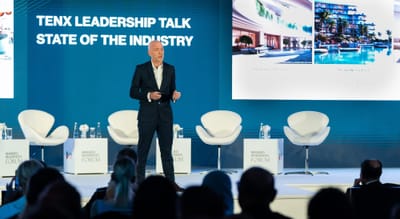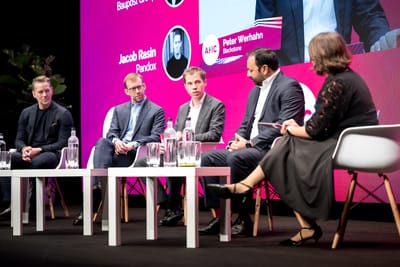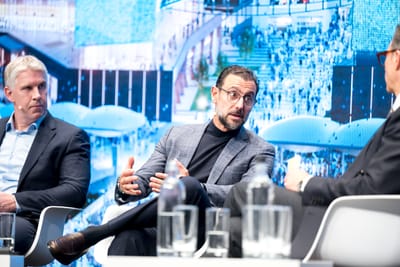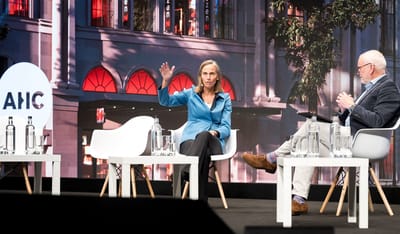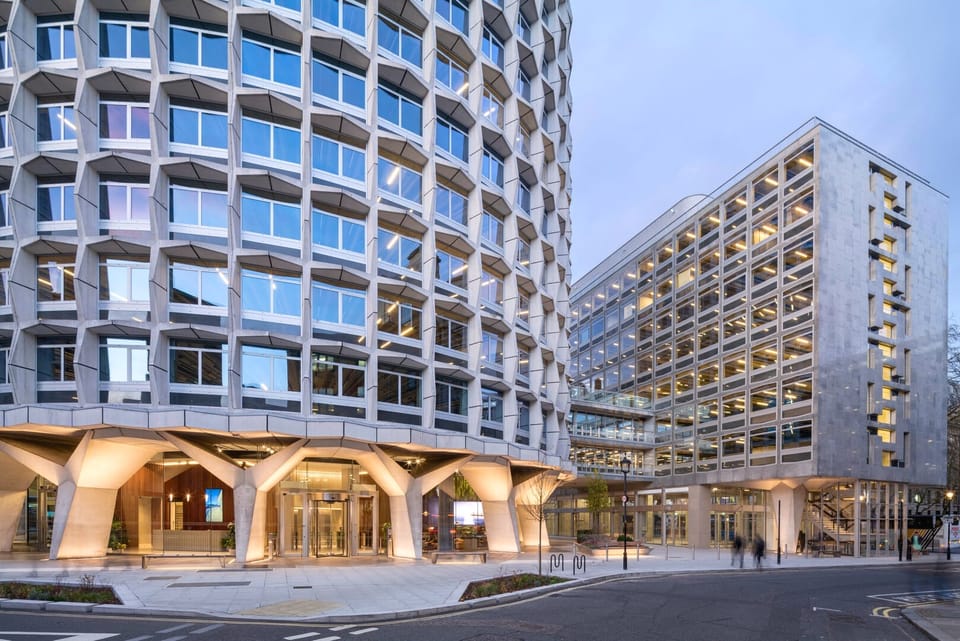
On Wednesday evening the NLA’s London Centre was buzzing with architects, developers, planners and campaigners for the launch of Adaptive London: Re-using Existing Buildings, the organisation’s latest research report and exhibition. But the real electricity came from three short keynote talks that distilled years of practice, activism and investment into a single, urgent refrain: London already has most of the buildings it needs – the challenge is to love them back to life.
Fred Pilbrow – Retrofit as creative liberation
Fred Pilbrow opened with what he called “the counter-intuition of retrofit”. Too often, he argued, a building is dismissed as “horrible” before anyone has mined its hidden opportunities. He illustrated the point with two current projects:
- From department store to daylight gallery – Pilbrow’s studio has just completed the metamorphosis of a tired 20th-century store into headquarters for an eyewear brand. Stripping away the façade revealed generous brick piers and a 26-metre-high void; by pushing the cores to one side the team carved out a dramatic, top-lit gallery floor that could never have been achieved in a conventional new-build frame.
- Science in a Salvation Army shell – At the former Salvation Army headquarters, now destined to house high-tech research labs for a medical charity, the practice is threading 21st-century vibration-free services through an early-1900s concrete structure. “It’s blood, sweat and tears,” Pilbrow admitted, “but the payoff is a building that carries its social history into a new era of public benefit.”
The architect’s broader plea was for “evidence-based decision-making”. In the ferocious debate ignited by last year’s M&S Oxford Street inquiry, he said, emotion often trumped data. A rigorous comparison of operational energy, embodied carbon and urban character should precede any decision to demolish. Where demolition is the answer, reuse should still be the instinct: he and engineer Kevin McGrath are exploring how to recast reclaimed concrete from one West End block into ultra-low-carbon homes on another site.
Leanne Tritton – Turning frustration into a movement
If Pilbrow spoke as a designer, Leanne Tritton took the microphone as a campaigner. The communications strategist and London Society chair co-founded Don’t Waste Buildings (DWB) in 2022 out of exasperation with Westminster’s lack of a road-map for meeting the legally binding 2050 net-zero target. “Where’s the plan?” she asked – and when the answer came back “There isn’t one,” she decided to write it herself.
The grass-roots group began with ten people around a table; today its LinkedIn forum has 1,800+ members and its “hymn sheet” – a plain-English set of asks for ministers and mayors – is being passed hand-to-hand across the industry. Among the priorities:
- Level the fiscal playing field – Zero-rate VAT on retrofit to match new-build, and fix other “perverse” incentives that reward demolition.
- Create policy clarity – End the postcode lottery in local planning guidance so that architects and investors can predictably price risk.
- Look beyond London – Showcase retrofit successes in peripheral towns and cities where rental values are lower and the financing gap wider.
Tritton’s communications instinct is to keep the message simple. Reusing bags at the supermarket became second nature when the plastic-bag tax arrived; reusing buildings, she insists, must become equally normalised. To that end DWB now organises political “walk-abouts”, taking MPs, councillors and journalists into extraordinary retrofit projects and letting the spaces do the persuasion.
“If you want to solve the housing crisis, start with the 670,000 homes Historic England says could be created from existing stock,” she reminded the audience, before urging volunteers to sign up for the next regional chapter.
Debbie Whitfield – Finance, pragmatism and radical listening
Debbie Whitfield, Director of Regeneration & Impact at Fabrix, grounded the conversation in the messy reality of the balance-sheet. Her developer’s “reuse-first ethos”, she explained, collides daily with assets that have suddenly been stranded by shifting occupier demands and tightening EPC rules.
“Not every building needs – or can afford – the full bells-and-whistles Passivhaus treatment,” she warned. Instead Fabrix targets focused, high-impact interventions: electrifying the building’s core, opening façades for light and ventilation, and adding the touches that tenants value most – greenery, showers, bike hubs, places to meet. Their 2000-era office on Cheapside is being revived this way, proving that incremental upgrades can decarbonise quickly without “throwing the kitchen sink – and the cap-ex budget – at the problem”.
Whitfield’s second, and passionate, theme was authentic community engagement. In Ealing, where Fabrix is remodelling a derelict office block on the A40, early workshops with neighbours produced a startling brief: affordable housing over a high-street of local shops, topped by a charity-run community kitchen and garden. Even the controversial addition of two slender Build-to-Rent towers won support once residents “could see their fingerprints on every layer of the scheme”.
Different though their roles are, the three speakers converged on four big ideas:
- Reuse unlocks creativity and character – Whether it is Pilbrow coaxing a cathedral-like atrium from a tired shell, or Fabrix keeping the quirks that tenants fall in love with, retrofit can deliver spaces that new-build formulas rarely match.
- Data, not dogma – Life-cycle carbon, social value and economic viability must be compared case-by-case. Nuance beats blanket bans or blank-slate redevelopment.
- Policy and finance must align – From VAT reform to clearer planning rules, government can tip the scales so that the greenest choice is also the simplest.
- People make projects – Community engagement, political storytelling and shared professional learning all determine whether a retrofit idea survives the boardroom and the committee chamber.
Beyond the lectern
Adaptive London itself amplifies those messages, profiling everything from coal-fired power stations reborn as cultural hubs to modest suburban high-streets stitched back together by small-scale infill. The exhibition at the London Centre runs until October, and an online directory maps each case study for deeper exploration.
As the audience drifted into the model gallery for networking – many no doubt eyeing their own “ugly ducklings” with fresh optimism – the evening left a clear takeaway: London doesn’t lack space; it lacks excuses. The policies, precedents and passion are in place. Now, as Whitfield put it, “the clock is ticking” – and every existing building is a chance to prove that net-zero development can be both profitable and profoundly human.
Become a subscriber receive the latest updates in your inbox.


